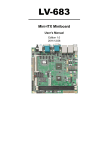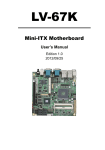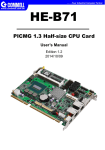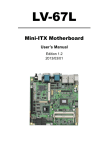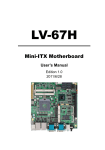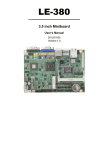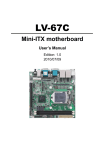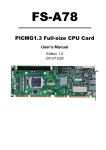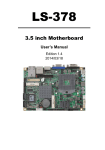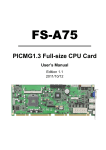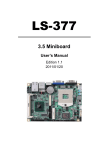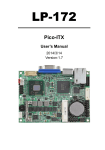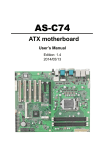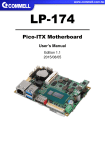Download User`s manual
Transcript
LV-683 Mini-ITX Miniboard User’s Manual Edition 1.1 2012/01/09 LV-683 User’s Manual Copyright Copyright 2011. All rights reserved. This document is copyrighted and all rights are reserved. The information in this document is subject to change without prior notice to make improvements to the products. This document contains proprietary information and protected by copyright. No part of this document may be reproduced, copied, or translated in any form or any means without prior written permission of the manufacturer. All trademarks and/or registered trademarks contains in this document are property of their respective owners. Disclaimer The company shall not be liable for any incidental or consequential damages resulting from the performance or use of this product. The company does not issue a warranty of any kind, express or implied, including without limitation implied warranties of merchantability or fitness for a particular purpose. The company has the right to revise the manual or include changes in the specifications of the product described within it at any time without notice and without obligation to notify any person of such revision or changes. Trademark All trademarks are the property of their respective holders. Any questions please visit our website at http://www.commell.com.tw TU -1- UT LV-683 User’s Manual Packing List: Please check the package content before you starting using the board. Hardware: LV-683 Mini-ITX motherboard x 1 Cable Kit: SATA Cable x 2 (OALSATA-L) DC Power Cable x 1 (OALDC-2) (OSCREW-8) * 2 ATX Power Output Cable x 1 (OALATX-P3S2) COM port & Printer Port Cable x 1 (OALES-BKU-3) I/O Shield x 1 (OPLATE-67E) DVI Module With DVI Cable x 1 (BADPDVI-A + OALDVI-DF13) Optional Cable Kit: Dual COM PORT cable (OALES-BKU2NB) USB Cable x 1 (OALUSBA-1) Printed Matters: Driver CD x 1 (Including User’s Manual) -2- LV-683 User’s Manual Index Chapter 1 <Introduction> ................................................................ 6 1.1 <Product Overview>..............................................................................................6 1.2 <Product Specification> ........................................................................................7 1.3 <Mechanical Drawing> .........................................................................................9 1.4 <Block Diagram> ................................................................................................10 Chapter 2 <Hardware Setup> ..................................................... 11 2.1 <Connector Location> .........................................................................................11 2.2 <Jumper Reference>............................................................................................12 2.3 <Connector Reference> .......................................................................................13 2.3.1 <Internal Connector> ........................................................................13 2.3.2 <External Connector> .......................................................................13 2.4 <CPU and Memory Setup>..................................................................................14 2.5 <CMOS & ATX Setup> ......................................................................................15 2.6 <SATA & CFast Interface>.................................................................................16 2.8 <LAN Interface> .................................................................................................17 2.9 <Onboard Display Interface> ..............................................................................18 2.9.1 <Analog VGA Interface>..................................................................18 2.9.2 <Digital Display>..............................................................................19 2.9.3 <DVI Interface > ...............................................................................23 2.10 <Onboard Audio Interface>...............................................................................24 2.11 <USB2.0 Interface>...........................................................................................25 2.12 <PCIE Mini Card and SIM Interface>...............................................................26 2.12.1 <SIM Setup> ...................................................................................27 2.13 <GPIO Interface> ..............................................................................................29 2.14 <Serial Port Jumper Setting >............................................................................30 2.15 <Power & FAN Connector > .............................................................................32 2.15.1 <Power Input>.................................................................................32 2.15.2 <Power Output> ..............................................................................33 2.15.3 <Fan Connector>.............................................................................34 -3- LV-683 User’s Manual 2.16 <Indicator and Switch>......................................................................................35 Chapter 3 <BIOS Setup> ............................................................... 37 Appendix A <I/O Port Pin Assignment>............................. 39 A.1 <SATA Port>......................................................................................................39 A.2 <IrDA Port> ........................................................................................................39 A.3 <SMBUS Port>...................................................................................................39 A.4<LPT Port> ..........................................................................................................40 A.5 < CRT Port >.......................................................................................................40 A.6 <Serial Port>.......................................................................................................41 A.7 <LAN Port> ........................................................................................................41 A.8 <LAN LED Port> ...............................................................................................41 Appendix B <Flash BIOS>............................................................ 42 B.1 <Flash Tool> .......................................................................................................42 B.2 <Flash BIOS Procedure> ....................................................................................42 Appendix C <System Resources> ......................................... 43 C.1 <I/O Port Address Map> .....................................................................................43 C.2 <Memory Address Map > ...................................................................................45 C.3 < System IRQ Resources > .................................................................................47 Appendix D <Programming GPIO’s> ................................... 48 Appendix E <Watch Dog timer Setting > ........................... 49 Appendix F <AMD Hing Definition Audio Device > ... 50 Contact Information .......................................................................... 51 -4- LV-683 User’s Manual (This page is left for blank) -5- LV-683 User’s Manual Chapter 1 <Introduction> 1.1 <Product Overview> LV-683 is the Mini-ITX motherboard with AMD G-T56N platform, with onboard VGA, Realtek ALC888 HD Codec audio, Giga LAN interface. Based on the AMD G-T56N Processor, the board provides many advanced features for reduced power consumption. A55E Chipset The board integrates AMD A55E supports, to provide built-in UniChrome Pro 3D / 2D Graphics with MPEGII/MPEG4 decoder, and supports DDRIII 1066/1333 memory up to 8G of capacity. The A55E has Ultra V-Link Host interface with 1 GB/sec total bandwidth to enhance the system performance. 18-bit LVDS LCD interface The board provides onboard 18-bit LVDS LCD interface, supports up to 1600 x 1200 of UXGA high resolution. Flexible Extension Interface The board also provides one mini PCI socket and one PCI Express Mini card socket and PCI Slot. -6- LV-683 User’s Manual 1.2 <Product Specification> General Specification Form Factor CPU Memory Chipset Watchdog Timer Real Time Clock Serial ATA Mini-ITX motherboard AMD G-T56N Processor 1.65GHz 2 x 240-pin DDR3 1066/1333MHz SDRAM up to 8GB Unbufferred, none-ECC memory supported only AMD A55E FCH System reset programmable watchdog timer with 1 ~ 255 sec./min. of timeout value Chipset integrated RTC with onboard lithium battery 4 x serial ATAII interface with 300MB/s transfer rate Multi-I/O Port Chipset Serial Port USB Port IrDA Port K/B & Mouse GPIO Winbond W83627DHG-P Five RS-232 and One RS-232/422/485 serial port Ten Hi-Speed USB 2.0 ports with 480Mbps of transfer rate One IrDA compliant Infrared interface supports SIR PS/2 keyboard and mouse port One 12-pin Digital I/O connector with 8-bit programmable I/O interface VGA Display Interface Chipset Frame Buffer Display Type Connector AMD A55E FCH (System Controller Hub) Up to 512MB shared with system memory CRT, LCD monitor with analog display, single channel DVI, LVDS External DB15 female connector Onboard 20-Pin LVDS and 5-Pin inverter connector Onboard 20-Pin DVI and 5-Pin Ethernet Interface Controller Type Connector 2 x Intel® 82583V Gigabit Ethernet controller Triple speed 10/100/1000Base-T auto-switching Fast Ethernet Full duplex, IEEE802.3U compliant Two External RJ45 connector with LED Audio Interface Chipset Interface REALTEK ALC888 Stereo audio Line-out and MIC-in Connector Onboard audio connector with pin header Expansive Interface PCIE PCI 1 x PCIE Mini Card socket 1 x Mini PCI Card socket & PCI Card -7- LV-683 User’s Manual Power and Environment Power Requirement Dimension Temperature Standard 20-pin ATX power supply or 5~24V full range DC Input 170 (L) x 170 (H) mm Operating within 0 ~ 60℃ Storage within -20 ~ 85℃ The specifications may be different as the actual production. For further product information please visit the website at http://www.commell.com.tw TU -8- UT LV-683 User’s Manual 1.3 <Mechanical Drawing> -9 - LV-683 User’s Manual 1.4 <Block Diagram> CRT / DVI / LVDS 2 x 240-pin DDR3 1066/1333MHz up to 8GB AMD G-T56N Processor HD Audio PCI Express mini card FCH 10 x USB port Mini PCI & PCI 4 x SATA 2 x Giga LAN W83627DHG-P 2 x Serial ports IrDA 8-bit GPIO COM3/4/5/6 -10- LV-683 User’s Manual Chapter 2 <Hardware Setup> 2.1 <Connector Location> CN AUDIO CN_COM5/6 CN_COM4 CN_LPT DC_IN Mini PCI CN_SMBUS CN_IR CN_LVDS CN_DIO CN_DVI PCI SATA1/2/3/4 CN_INV MINI_CARD CPUFAN DDR3_A&B CN_USB1/2 CN_LPC SYSFAN JFRNT LV-683 COM1 PS2 RJ45& USB CRT -11- COM3 COM2 Audio SPDIF LV-683 User’s Manual 2.2 <Jumper Reference> Jumper JRTC JAT JCSEL1/2 Function CMOS Operating/Clear Setting AT/ATX Mode Setting COM2 RS232/422/485/IrDA Mode Setting JP1 JP2 JVUSB JVLCD COM3 signal mode switch (For Pin-9) COM4 signal mode switch (For Pin-9) USB Voltage Setting Panel Voltage Setting JP1 JCSEL2 JP2 JCSEL1 JVLCD JAT JVUSB JCSEL2 JRTC -12- LV-683 User’s Manual 2.3 <Connector Reference> 2.3.1 <Internal Connector> Connector CPU DDRIIIA/B S_ATAII1/2/3/4/ ATX DC_IN CN_AUDIO CDIN CN_DIO CN_USB1/2/3 CPUFAN SYSFAN CN_IR CN_SMBUS JFRNT PCI Mini-PCI CN_DVI CN_COM4/5/6 MINI_CARD CN_INV CN_LVDS CN_LPT Function LGA1155 CPU socket 240 –pin DDR3 SDRAM DIMM socket 7-pin Serial ATA II connector 24-pin power supply connector 4-pin +12V additional power supply connector 5 x 2-pin audio connector 4-pin CD-ROM audio input connector 6 x 2-pin digital I/O connector 10-pin USB connector 4-pin CPU cooler fan connector 3-pin system cooler fan connector 5-pin IrDA connector 5-pin SMBUS connector 14-pin front panel switch/indicator connector 120-Pin PCI socket 124-pin Mini-PCI socket 26 Pin connector 5 x 2-pin com connector 1 x 52-pin PCI Express mini card 5-pin LCD inverter connector 20 x 2-pin LVDS connector 26 -pin LVDS connector Remark 2.3.2 <External Connector> Connector PS2 CRT+COM1 USB_RJ45_1/2 COM 2/3 AUDIO SPDIF Function PS/2 Keyboard/Mouse connector DB15 VGA + Serial port connector Dual USB and one RJ45 LAN Port Serial port connector Audio connectors SPDIF digital audio output connector -13- Remark LV-683 User’s Manual 2.4 <CPU and Memory Setup> LV-683 has two 240-pin DDR3 DIMM support up to 8GB of memory capacity. The memory frequency supports 1066/1333 MHz. Only Non-ECC memory is supported. DDR3A&B -14- LV-683 User’s Manual 2.5 <CMOS & ATX Setup> The board’s data of CMOS can be setting in BIOS. If the board refuses to boot due to inappropriate CMOS settings, please remove battery to clear (reset) the CMOS to its default values. JAT JAT 1 3 JRTC 1 3 Jumper: JRTC Type: onboard 3-pin jumper JAT Mode 1-2 Clear CMOS 2-3 Normal Operation Default setting Jumper: JAT Type: onboard 3-pin jumper JRTC Mode 1-2 AT Mode 2-3 ATX Mode Default setting -15- LV-683 User’s Manual 2.6 <SATA & CFast Interface> Based on Intel A55E, the board provides Four Serial ATAII interfaces with up to 300MB/s of transfer rate. SATA1/2/3/4 -16- LV-683 User’s Manual 2.8 <LAN Interface> The board integrates with two Intel 82583V Gigabit Ethernet controllers, as the PCI Express bus. The Intel 82583V supports triple speed of 10/100/1000Base-T, with IEEE802.3 compliance and Wake-On-LAN supported. LAN1 LAN2 -17- LV-683 User’s Manual 2.9 <Onboard Display Interface> Based on AMD G-T56N chipset with built-in AMD Radeon HD 6300 series Graphics, the board provides one DB15 connector on real external I/O port, and one 20-pin DVI and one LVDS interface with 5-pin LCD backlight inverter connector. The board provides dual display function with clone mode and extended desktop mode for CRT, DVI and LVDS. 2.9.1 <Analog VGA Interface> Please connect your CRT or LCD monitor with DB15 male connector to the onboard DB15 female connector on rear I/O port. The board supports up to 1920 x 1080 (WUXGA) of resolution. CRT -18- LV-683 User’s Manual 2.9.2 <Digital Display> The board provides one 20-pin LVDS for 18 bit single channel panels, supports up to 1600 x 900 of resolution, with one LCD backlight inverter connector and one jumper for panel voltage setting CN_LVDS 2 1 20 19 CN_INV 1 5 -19- LV-683 User’s Manual Connector: CN_INV Type: 5-pin Inverter power connector Connector model: JST B5B-XH-A Pin 1 2 3 4 5 Description +12V LVDS_VARY_BL GND GND INV_ON Jumper: JVLCD Type: 3-pin Power select jumper Pin Description 1-2 +5V 2-3 +3.3V Default: 2-3 Connector: CN_LVDS Type: onboard 20-pin connector for LVDS connector Connector model: HIROSE DF13-20DP-1.25V Pin 1 3 5 7 9 11 13 15 17 19 Signal LCDVCC GND TX0N GND TX1P TX2N GND CLKP AUXP GND Pin 2 4 6 8 10 12 14 16 18 20 -20- Signal LCDVCC GND TX0P TX1N GND TX2P CLKN GND AUXN NC LV-683 User’s Manual To setup the LCD, you need the component below: 1. A panel with LVDS interfaces. 2. An inverter for panel’s backlight power. 3. A LCD cable and an inverter cable. For the cables, please follow the pin assignment of the connector to make a cable, because every panel has its own pin assignment, so we do not provide a standard cable; please find a local cable manufacture to make cables. LCD Installation Guide: 1. Preparing the LV-683, LCD panel and the backlight inverter 2. You would need a LVDS type cable. Panel side Board side For sample illustrator only 3. To connect all of the devices well. -21- LV-683 User’s Manual After setup the devices well, you need to select the LCD panel type in the BIOS. The panel type mapping is list below: LV-683 BIOS panel type selection form On board Single channel LVDS 18bit NO. Output format 1 800 x 600 2 1024 x 768 3 1280 x 720 4 1280 x 800 5 1280 x 1024 6 1366 x 768 7 1440 x 900 -22- LV-683 User’s Manual 2.9.3 <DVI Interface > The board also comes with a DVI interface. Supports up to 1600 x 1200 (UXGA) of resolution. Connector: CN_DVI Connector type: HIROSE DF13-20DP-1.25V Pin Number 1 3 5 7 9 11 13 15 17 19 Assignment +5V HPD TMDSTX0N Ground TMDSTX1P TMDSTX2N Ground TMDSTXCP DVI_DA AUXN Pin Number 2 4 6 8 10 12 14 16 18 20 Assignment +3.3V Ground TMDSTX0P TMDSTX1N Ground TMDSTX2P TMDSTXCN Ground DVI_SL AUXP CN_DVI -23- 2 1 20 19 LV-683 User’s Manual 2.10 <Onboard Audio Interface> The board provides the onboard high definition audio with Realtek ALC888 Connector: CN_AUDIO Type: 10-pin (2 x 5) 1.27mm x 2.54mm-pitch header Pin Description Pin Description 1 MIC2_L 2 AGND 3 MIC2_R 4 AVCC 5 FRO_R 6 MIC2_JD 7 F_IO_SEN 8 N/C 9 FRO_L 10 LINE2_JD 9 1 10 2 CN_AUDIO -24- LV-683 User’s Manual 2.11 <USB2.0 Interface> Based on AMD A55E FCH, the board provides Ten USB2.0 ports. The USB2.0 interface provides up to 480Mbps of transferring rate. Interface USB2.0 Controller A55E Transfer Rate Up to 480Mb/s Output Current 500mA CN_USB1/2/3 1 2 USB Connector: CN_USB1/2/3 Type: 10-pin (5 x 2) header for USB Port Pin Description Pin 1 VCC 2 3 D04 5 D0+ 6 7 Ground 8 9 Ground 10 -25- Description VCC D1D1+ Ground N/C LV-683 User’s Manual 2.12 <PCIE Mini Card and SIM Interface> The board provides one PCIE mini card sockets and a SIM socket. MINI_CARD support 3G PCIE Mini card with SIM. MINI_CARD 3 2 1 7 6 5 Connector: SIMM Type: 6-pin SIM socket Pin 1 3 5 7 Description SIMVCC SIMCLK GND SIMDATA Pin 2 4 6 -26- Description SIMRST NC SIMVPP LV-683 User’s Manual 2.12.1 <SIM Setup> Step1. SIM card holder is marked by circle. Slide the cap toward OPEN direction. Step 2. Make sure that the cap is now at the OPEN position. Step 3. Flip the cap up for inserting a SIM card into. -27- LV-683 User’s Manual Step 4. Insert a SIM card as shown in the photo. Be sure that the corner cut is on top and the golden pads are up. Step 5. Now, flip down the cap as shown in the photo. Step 6. Press down and slide the cap to the CLOSE position. Be sure that the cap is tightly held with the socket. -28- LV-683 User’s Manual 2.13 <GPIO Interface> The board provides a programmable 8-bit digital I/O interface; you can use this general purpose I/O port for system control like POS or KIOSK. Connector: CN_DIO Type: onboard 2 x 6-pin header, pitch=2.0mm Pin 1 3 5 7 9 11 1 Description Ground GP10 GP11 GP12 GP13 +5V Pin 2 4 6 8 10 12 2 CN_DIO 11 12 -29- Description Ground GP14 GP15 GP16 GP17 +12V LV-683 User’s Manual 2.14 <Serial Port Jumper Setting > The board provides Six RS232 serial ports, with jumper selectable RS422/485/IrDA for COM2. Connector: COM2 Type: 10-pin (5 x 2) 1.27mm x 2.54mm-pitch header for COM2 Pin 1 3 5 7 9 Description DCD/422TX-/485TXD/422RX+ GND RTS RI Pin 2 4 6 8 10 COM2 -30- Description RXD/422TX+/485+ DTR/422RXDSR CTS N/C LV-683 User’s Manual Jumper: JCSEL1/2 Type: 12-pin (6 x 2) & 8-pin (4 x 2) for set COM2 mode jumper RS232 RS485 RS422 IrDA 11 1 11 1 11 1 11 1 12 7 2 1 12 7 2 1 12 7 2 1 12 7 1 8 2 8 8 2 JCSEL1 2 JCSEL2 2 8 Default: RS232 11 1 7 12 2 8 1 JCSEL1 JCSEL2 2 -31- 2 LV-683 User’s Manual 2.15 <Power & FAN Connector > 2.15.1 <Power Input> The board requires onboard 4-pin DC-input connector voltage range is from 5V to 24V, or onboard 20-pin ATX2.0, for the input current, please take a reference of the power consumption report on appendix. Connector: ATX (It also can become Output when DC-IN be used) Type: 20-pin ATX power connector Pin Assignment Pin Assignment 1 3.3V 11 3.3V 2 3.3V 12 -12V 3 GND 13 GND 4 5V 14 -PSON 5 GND 15 GND 6 5V 16 GND 7 GND 17 GND 8 PW_OK 18 N/C 9 5V_SB 19 5V 10 12V 20 5V 3 1 DC_IN 2 4 ATX 20 11 10 1 Connector: DC_IN Type: 4-pin standard Pentium 4 additional +5~24V power connector Pin Description Pin Description 1 Ground 2 Ground 3 +5~24V 4 +5~24V -32- LV-683 User’s Manual 2.15.2 <Power Output> The board provides one 20-pin ATX connector for +5V/+12V output for powering your HDD, CDROM or other devices. Attention: When DC-IN had power supplied, the ATX become output ! Avoid DC-IN and ATX power supply input at the same time ! Connector: ATX (When DC-IN be used) Type: 20-pin ATX connector for +3.3V/+5V/+12V Output Pin Assignment Pin Assignment 1 3.3V 11 3.3V 2 3.3V 12 * 3 * 13 * 4 5V 14 * 5 GND 15 * 6 * 16 GND 7 GND 17 GND 8 * 18 * 9 * 19 5V 10 12V 20 5V Note: Maximum output voltage: 12V/2A & 5V/3A &3.3V/2A -33- LV-683 User’s Manual 2.15.3 <Fan Connector> Connector: CPUFAN Type: 4-pin fan wafer connector Pin Description 1 Ground 3 Fan Speed Detection Connector: SYSFAN Type: 3-pin fan wafer connector Pin Description Pin 1 Ground 2 Pin 2 4 Description +12V Fan Control Description +12V Pin 3 Description Sense CPUFAN 1 4 1 3 SYSFAN -34- LV-683 User’s Manual 2.16 <Indicator and Switch> The JFRNT provides front control panel of the board, such as power button, reset and beeper, etc. Please check well before you connecting the cables on the chassis. Connector: JFRNT Type: onboard 14-pin (2 x 7) 2.54-pitch header Function Signal PIN Signal HDLED+ 1 2 PWDLED+ HDLED- 3 4 N/C Reset+ 5 6 PWDLED- Reset- 7 8 SPKIN+ N/C 9 10 N/C Power PWRBT+ 11 12 N/C Button PWRBT- 13 14 SPKIN- IDE LED Function Power LED Reset Speaker 13 1 JFRNT 14 2 -35- LV-683 User’s Manual (This Page is Left For Blank) -36- LV-683 User’s Manual Chapter 3 <BIOS Setup> The motherboard uses the Award BIOS for the system configuration. The Award BIOS in the single board computer is a customized version of the industrial standard BIOS for IBM PC AT-compatible computers. It supports Intel® x86 and compatible CPU architecture based processors and computers. The BIOS provides critical low-level support for the system central processing, memory and I/O sub-systems. The BIOS setup program of the single board computer let the customers modify the basic configuration setting. The settings are stored in a dedicated battery-backed memory, NVRAM, retains the information when the power is turned off. If the battery runs out of the power, then the settings of BIOS will come back to the default setting. The BIOS section of the manual is subject to change without notice and is provided here for reference purpose only. The settings and configurations of the BIOS are current at the time of print, and therefore they may not be exactly the same as that displayed on your screen. To activate CMOS Setup program, press <DEL> key immediately after you turn on the system. The following message “Press DEL to enter SETUP” should appear in the lower left hand corner of your screen. When you enter the CMOS Setup Utility, the Main Menu will be displayed as Figure 4-1. You can use arrow keys to select your function, press <Enter> key to accept the selection and enter the sub-menu. Figure 4-1 CMOS Setup Utility Main Screen -37- LV-683 User’s Manual (This Page is Left for Blank) -38- LV-683 User’s Manual Appendix A <I/O Port Pin Assignment> A.1 <SATA Port> 1 7 Connector: SATA1/2/3/4 Type: 7-pin wafer connector 1 2 3 4 5 6 7 GND RSATA_TXP1 RSATA_TXN1 GND RSATA_RXN1 RSATA_RXP1 GND A.2 <IrDA Port> Connector: CN_IR Type: 5-pin header for SIR Port Pin 1 2 3 4 5 1 5 1 5 Description VCC N/C IRRX Ground IRTX A.3 <SMBUS Port> Connector: CN_SMBUS Type: 5-pin header for SMBUS Port Pin 1 2 3 4 5 Description VCC N/C SMDATA SMCLK Ground -39- LV-683 User’s Manual 14 25 1 13 A.4<LPT Port> Connector: CN_LPT Type: 26-pin header for LPT Port Pin 1 2 3 4 5 6 7 8 9 10 11 12 13 Description -PSTB PRD0 PRD1 PRD2 PRD3 PRD4 PRD5 PRD6 PRD7 ACKBUSY PE SLCT 14 15 16 17 18 19 20 21 22 23 24 25 26 AFDERRINITSLINGND GND GND GND GND GND GND GND N/C A.5 < CRT Port > Connector: CRT Type: 15-pin D-sub female connector on rear panel Pin 1 2 3 4 5 Description RED GREEN BLUE N/C Ground Pin 6 7 8 9 10 Description Ground Ground Ground LVGA5V Ground -40- 5 1 15 11 10 Pin 11 12 13 14 15 6 Description N/C 5VCDA HSYNC VSYNC 5VCLK LV-683 User’s Manual A.6 <Serial Port> 1 Connector: COM1 Type: 9-pin D-sub male connector on rear panel Pin 1 2 3 4 5 Description DCD SIN SO DTR Ground Pin 6 7 8 9 5 6 9 Description DSR RTS CTS RI A.7 <LAN Port> Connector: RJ45 Type: RJ45 connector with LED on rear panel 8 1 Pin 1 2 3 4 5 6 7 8 Description TRD0+ TRD0- TRD1+ TRD2+ TRD2- TRD1- TRD3+ TRD3- A.8 <LAN LED Port> Connector: JSPD1/2 Type: 5-pin header for LAN Speed LED connector When Lan speed 10/100Mbps Pin 1 2 1 2 Description LEDLED+ When Lan speed 1Gbps Pin 1 2 Description LED+ LED- 2 Connector: JATC1/2 Type: 5-pin header for LAN Activity LED connector Pin 1 2 Description LEDLED+ -41- 1 LV-683 User’s Manual Appendix B <Flash BIOS> B.1 <Flash Tool> The board is based on Phoenix BIOS and can be updated easily by the BIOS auto flash tool. You can download the tool online at the address below: http://www.phoenix.com/en/home/ http://www.commell.com.tw/Support/Support_SBC.htm File name of the tool is “Pflash.exe”, it’s the utility that can write the data into the BIOS flash ship and update the BIOS. B.2 <Flash BIOS Procedure> 1. Please make a bootable floppy disk. 2. Get the last .bin files you want to update and copy it into the disk. 3. Copy Pflash.exe to the disk. 4. Power on the system and flash the BIOS. (Example: C:/Pflash /bbl /cvar /sa XXX.bin) 5. Restart the system. Any question about the BIOS re-flash please contact your distributors or visit the web-site at below: http://www.commell.com.tw/support/support.htm UT -42- LV-683 User’s Manual Appendix C <System Resources> C.1 <I/O Port Address Map> -43- LV-683 User’s Manual -44- LV-683 User’s Manual C.2 <Memory Address Map > -45- LV-683 User’s Manual -46- LV-683 User’s Manual C.3 < System IRQ Resources > -47- LV-683 User’s Manual Appendix D <Programming GPIO’s> The GPIO can be programmed with the MS-DOS debug program using simple IN/OUT commands.The following lines show an example how to do this. GPIO0…..GPIO7 -o 2E 87 bit0……bit7 ;enter configuration. -o 2E 87 -o 2E 07 -o 2F 09 ;select logic device 9. -o 2E 30 -o 2F 02 ;active GPIO3. -o 2E F0 -o 2F xx ;set GPIO as input/output; set ‘1’ for input,’0’for output. -o 2E F1 -o 2F xx ;if set GPIO’s as output,in this register its value can be set Optional : -o 2E F2 -o 2F xx ; Data inversion register ; ‘1’ inverts the current valus of the bits ,’0’ leaves them as they are For further information, please refer to Winbond W83627DHG-P datasheet. -48- LV-683 User’s Manual Appendix E <Watch Dog timer Setting > The watchdog timer makes the system auto-reset while it stops to work for a period. The integrated watchdog timer can be setup as system reset mode by program. Timeout Value Range - 1 to 255 - Second or Minute Program Sample Watchdog timer setup as system reset with 5 second of timeout 2E, 87 2E, 87 2E, 07 2F, 08 Logical Device 8 2E, 30 2F, 01 Activate 2E, F5 2F, 02 Set as Second* 2E, F6 2F, 05 Set as 5 * Minute: bit 3 = 1; Second: bit 3 = 0 You can select Timer setting in the BIOS, after setting the time options, the system will reset according to the period of your selection. -49- LV-683 User’s Manual Appendix F <AMD Hing Definition Audio Device > 1. Please choose “Device Manager” 2. You can see other devices ”Audio Device on High Definition Audio Bus” 3. Please choose “Audio Device on High Definition Audio Bus” then press Update Driver 4. Please select the file location”D:\LV-683\Audio(XP)\XP” 5. Install finish -50- LV-683 User’s Manual Contact Information Any advice or comment about our products and service, or anything we can help you please don’t hesitate to contact with us. We will do our best to support you for your products, projects and business. Taiwan Commate Computer Inc. Address 19F., No.94, Sec. 1, Xintai 5th Rd., Xizhi Dist., New Taipei City 22102, Taiwan TEL +886-2-26963909 FAX +886-2-26963911 http://www.commell.com.tw Website TU UT [email protected] (General Information) TU UT E-Mail [email protected] (Technical Support) TU Facebook Twitter UT https://www.facebook.com/pages/Taiwan-Commate-Computer-Inc/547993955271899 https://twitter.com/Taiwan_Commate Commell is our trademark of industrial PC division -51-




















































